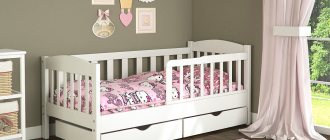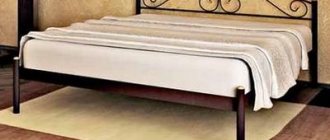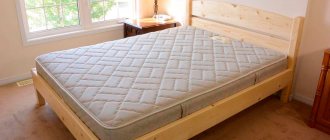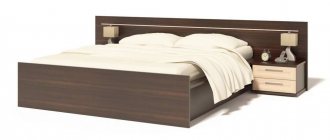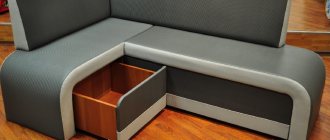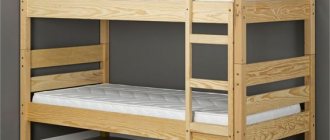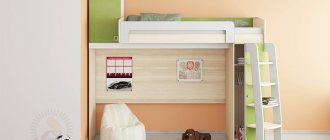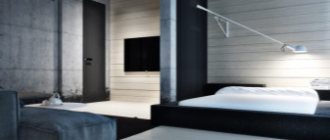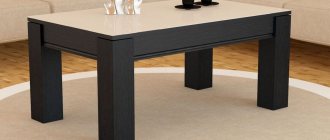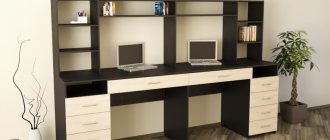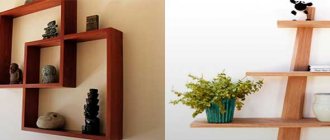Making something with your own hands is always nice. Such a thing will certainly take its rightful place, will ideally perform the functions assigned to it and will become an integral part of interior decoration. And if it’s not just a spacious drawer or a convenient shelf, but an entire bed - one of the most important pieces of furniture on which a person spends most of his time in the house - then it’s not enough to do “with love” to make it “pleasant to the eye.” The bed must be reliable, high-quality, comfortable and beautiful, so as not to spoil the appearance of the entire room, not cause unpleasant consequences of sleep disturbances and last for many years.
But, despite all these requirements for its manufacture, it is not necessary to have professional skills. It is enough to be proficient with the tool and follow the instructions carefully. And, before starting the process itself, you need to have a complete understanding of what you have to deal with.
In our article, we will help you first select the material for the bed in accordance with your needs, and then build the bed, or rather, how to make a bed frame with your own hands. The information is presented in an accessible, step-by-step manner; if you strictly follow our instructions, you will certainly succeed in creating the bed.
Interesting article about making a mattress with your own hands
Step-by-step instructions for making a bed
! It should be noted: manufacturing costs will be about 4135 rubles.
To work you should prepare:
- 1. Furniture panel 2000*300*18 mm, 2 pcs. – 1350 rubles.
- 2. Furniture panel 1200*300*18 mm, 2 pcs. – 806 rubles.
- 3. Beam 2000*40*50 mm, 3 pcs. — 1113 rubles.
- 4. Sheathing boards 1300*96*20 mm, 5 PCS. — 486 rubles.
- 5. Screws 3.5*45 mm 100 pcs. – 120 rubles.
- 6. Confirm screw 7x50 mm 14 pcs. – 150 rubles.
- 7. Screw M8*80 mm 4 pcs. – 74 rubles.
- 8. M8 nuts 4 pcs – 36 rubles.
Tools for making a bed:
- 1. Screwdriver.
- 2. Saw.
- 3. Sanding machine.
- 4. Measuring tape.
- 5. Level.
Assembly steps:
- First, the bed frame is assembled. To do this, furniture panels 1200 and 2000 meters long are fastened at the corners. To set a right angle, you can use a homemade chipboard corner (2 chipboard parts of the same size are connected perpendicular to each other using Euro screws). Furniture panels (bed frames) are secured with clamps.
- Next, the two drawers are fastened with confirmatory screws. You will need 3 screws for each corner of the bed.
- Next, you should check the diagonals of the bed: they must be measured with a tape measure. The length of the diagonals must be the same.
- Remains of timber are used for the legs. The length of the legs is about 180 mm.
- Next you need to prepare the timber. To do this, 2 thicknesses of furniture panels (36 mm) and 2 thicknesses of legs (100 mm) are sawn from the length of the beam.
- The prepared beam is tried on: for this, it is placed between the sides of the bed, and the legs are inserted into the corners. It should be a right angle.
- Next, a beam is screwed to each drawer, at a height of 140 mm from the lower edge of the furniture panel. Screws of 3.5 * 45 mm are used for every 10 cm.
- Next, the legs are fixed with a clamp and a through hole with a diameter of 8 mm is drilled. A screw is inserted and tightened with a nut.
- The frame is ready. It is necessary to check the level of the position of the sides of the bed relative to the floor.
- The next step is making the slats for the bed - these are the transverse slats on which the mattress is laid. To do this, the boards are cut and sawed to length from 1300 mm to 1250 mm. This is done to create a reserve for wood swelling.
- The prepared slats are laid on the bed beams at the same distance (30-50 mm). Next they are screwed to the beam. Use 2 screws on each side.
- To increase the strength of the bed, it is necessary to make a stiffening rib: for this, another beam is attached in the middle, parallel to the side beams, which will support the middle part of the bed.
- Next, you should sand the bed with a sander using sandpaper (grit 180).
- After sanding with a machine, the bed must be cleaned of dust and applied with Watco Danish Oil (light walnut).
All! The bed is ready.
The frame can be used as an independent bed, the head of which will be any wall of the room. If you want to make a full-fledged bed, then you need to think about making a headboard for it.
Modern wood stock
Quite often, the period of use of furniture in a bedroom is calculated in decades. However, making a wooden homemade modern bed is always a temptation for a real man.
You need to purchase planed bars, edged boards 22 and 42 mm, they need to be pre-treated with a sanding machine. If you wish, you can watch with passion a master class on how to make a bed yourself from wood. The rectangular base of the bed is assembled from planed boards according to the outer size of the mattress.
A central support beam should be added to the 2000mm wide bed base structure. The inner surface of the frame is covered with edged planed boards and secured with screws to the supporting strip of the side walls. The lower part of the legs should be made in the shape of a ball.
Now, along the perimeter of the frame on three sides, a wide board with a thickness of forty millimeters is attached to the frame. It should be 100 mm wider than the base of the bed. The headboard is made of any shape from planed boards and attached with screws to the rear wall of the base.
We assemble the basis of the product - its frame
Making a bed begins with determining its future dimensions. The average dimensions of a single bed are 100 cm wide and about 200 cm long. To make the frame, you can take several boards 25 cm wide and about 4 cm thick: 2 boards 200 cm long (for the sides) and 2 more 100 cm long (for the ends).
The parts are connected in several ways. The choice of any of them depends on the preferences and level of training of the master:
- Making your own bed using eyelets and wooden spikes. This is a rather complicated method, but it ensures reliable and high-quality connection of elements. The connection of the boards should be made W-shaped. The nests can be hollowed out with a chisel or cut out with a jigsaw. The grooves should be about 5 cm deep and about 2-3 cm wide. The corners of the grooves should be aligned at 90 degrees. Then the prepared joints should be coated with glue and assembled.
- Making a bed with a minimum of effort is possible by using self-tapping screws to connect the structural parts. In this case, it is recommended to strengthen the frame with metal corners.
The manufacture of a single or double bed involves the installation of additional longitudinal stiffeners from bars with a cross-section of at least 5x5 cm.
Progress
We assemble the frame. Let's start with a 40x95 mm board. Let's cut it for the legs. We should get 2 elements 910 mm long and 2 410 mm long.
Blanks for legs From a 45x20 mm board we will make the perimeter of the bed and a couple of blanks for the headboard. Since the factory cut of the workpieces is not very even, I will trim the workpieces manually with a Japanese saw. The peculiarity of this saw is the presence of very small teeth and their “multi-directionality”. This saw gives a beautiful thin cut.
I trim the blanks with a Japanese saw. The following frame parts are: 200 cm and 165 cm. We made them from boards with a section of 145x20 mm.
Blanks for the frame We will also prepare the parts on which the slatted bottom of the bed, an element for supporting the slats and a stand will rest. The stand will be attached to the support in the center of the bed. It is needed for greater reliability.
1. Two sidewalls on which the slatted bottom will rest; 2. a beam in the middle, which will take on part of the load. All ends and rough surfaces should be sanded. We will also soften the edges of the details. Using self-tapping screws, we attach the slats to the longitudinal walls of the frame, on which the slatted bottom will rest.
I attach the supports for the slatted bottom. To fix the legs to the bed, I used corners that would give rigidity in the diagonal direction, and in some places I attached the parts with an oblique screw.
We assemble the structure using corners and fastening with an oblique screw.
I highly recommend buying a jig for fastening “on an oblique screw”. You will need it more than once. The legs of the bed protrude 1 cm above the frame. We make the appropriate markings and attach the parts to the base of the frame. We connect all the parts of the bed frame. I assemble the parts at the headboard using an oblique screw and a corner, at the foot - only with an oblique screw.
Assembling the frame
The frame is ready
I'm trying on the slatted bottom. 6 hours have passed since the start of work. The bed frame was covered with teak oil right on the spot. I brushed the boards for the headboard to emphasize the active wood grain. I use nylon brushes for this. As a result, we obtain a surface ready to be coated with a decorative composition.
I didn’t start dusting the apartment. I brushed the boards for the headboard on the street. I connect two boards to each other “with an oblique screw” and fix them on the frame.
I connect the headboard and legs of the bed. We cover the finished frame with oil.
Useful tips
It is sometimes believed that using ordinary nails in the manufacture of furniture is no longer modern and impractical, but this is not so. Nails can not only become the cheapest element of fittings, but also make the carpenter’s work easier, without requiring any preparatory steps in the form of drilling.
Probably, few people realize that ordinary pallets from building materials can be used as a basis for a durable wooden bed.
They benefit not only with their cheap price, but also with their good quality, because poor wood is unlikely to be used for transporting and storing heavy bricks.
In addition, over time, such pallets are used for their intended purpose, the wood can shrink and dry perfectly, which is its undeniable advantage.
Pallets can be brought into a more decent appearance by sanding and connected to each other with long self-tapping dowels. To give them a minimal aesthetic appearance, they can also be painted and varnished. In order to make a full-fledged double bed, you will need only four of these construction pallets, and from eight or more pallets you can build any kind of podium.
You should not use chipboard to make bed legs : as already mentioned, this material, despite its widespread use, is not suitable for making parts that can withstand heavy loads. If you take this lightly and make the bed legs from wood chip material, at best they will begin to delaminate and the bed will constantly creak, and at worst they may simply not withstand the weight.
The bed itself is intended not only to support the mattress, but also must have properties that would evenly distribute the load between it and the bed frame. The boards on the bed should be laid loosely according to the lamella principle, and the plywood panel for the mattress itself should already be placed on top.
Slat boards are best laid transversely rather than longitudinally, because this is how they bend slightly downwards in accordance with body movements.
How to very easily make a bed with your own hands from wood
Before you start, you need to familiarize yourself with the types and standard sizes of beds for adults:
| Model | Width | Length | |
| 1 | Single | From 50 to 80 cm | 170‒200 cm |
| 2 | One and a half | From 100 to 120 cm | 120‒200 cm |
| 3 | Double | From 160 to 180 cm | 200‒220 cm |
You also need to take into account the load on the structure - the estimated maximum weight of people who will sleep on the bed or relax. And then, taking into account the data obtained, you should purchase boards and bars with the most suitable parameters.
The principle of making a wooden bed with your own hands is not so complicated. The frame should be made of solid wood, as it is easy to process. And such a product will look great. If you purchase high-quality materials, preferably without knots and pre-processed on a grinding machine, you can save not only time, but also effort.
Varieties
The conditional division of frameworks into types is as follows:
- separate - does not have a slatted bottom;
- a complete product with a base, legs and backs, drawers for things.
The main advantage of a separate frame is the ability to select any base - from classic flat to orthopedic with lamellas. This design allows you to focus attention on the frame of the bed. The element is manufactured taking into account the height and weight of users. To create it, various materials are used - solid wood, MDF, chipboard, metal. Such a frame is decorated in accordance with the tastes of the owner, as well as the design features of the room.
The complete structure consists of a frame and a base. The body of such a bed is made of wood, covered with soft upholstery, giving the room coziness. The advantage is that there is no need to additionally purchase a base. In addition, such products are suitable for large users because they are equipped with a metal frame and high-quality slats.
Classification of mattress covers for a bed, choosing the right size
Separate
With base
Fastening elements for solid wood products
During the manufacture of wooden beds, special attention is paid to fastening elements. Among these you will need:
- Wood screws (various lengths);
- Metal corners with a rounded stiffener (to make the wooden structure more reliable);
- Nails (not suitable for all wood).
For more reliable fastening of parts, it is recommended to use clamps.
How to choose self-tapping screws for fastening two specific parts:
- Measure the thickness of the part to which the second part will be attached;
- Measure the thickness of the part that is attached to the main one;
- Add both values (in mm);
- Subtract 10 mm from the resulting figure;
- The resulting value will indicate the length of the self-tapping screw required to fasten the 2 above-mentioned parts.
For example:
- The main part is 55 mm thick;
- The thickness of the attached part is 25 mm;
- 25+55=80mm;
- 80-10=70mm.
To fasten two parts (55 and 25 mm) with a total thickness of 80 mm, it is necessary to use self-tapping screws 70 mm long.
We detail the future bed
We have decided on the materials and tools; now we need to cut out the elements. If there is no special equipment and sufficient free space, then you should seek help from specialists. Moreover, in an apartment it is quite difficult to achieve rectangular sections when cutting. Since the bed is supposed to have a mattress, a base for it should be made of sixteen-millimeter plywood, the parameters of which are 1.6 by 2 meters. The remaining elements should be manufactured in specified quantities according to certain sizes, according to the developed drawing. From the main parts it is necessary to make the upper and lower base of the podium, the top for the headboard (1 piece), transverse stiffeners (at least three), two rigid transverse ribs, four limiters for the headboard and three racks.
Calculation of the quantity of materials
Below is a calculation of the necessary materials for do-it-yourself wooden beds. You can make this bed from solid pine because it is cheap. You can choose more expensive materials. The calculation of the required amount of wood is given in the table below.
| Material | Quantity, pcs | Size, mm | Purpose |
| Board | 3 | 50*100*2400 | Support beams |
| Board | 3 | 50*24*2400 | Decorative finishing |
| Board | 19 | 25*75*2400 | Making a bottom from slats |
| Board | 4 | 200*25*2400 | Frame making |
| timber | 1 | 2400*100*100 | Legs |
Materials
The amount of material is indicated for the manufacture of a bed with a mattress size of 2000 by 1500 mm. This is not a single bed, a bed of this size is suitable for two. If the mattress is of a different size, you will only need to slightly change the length of the boards, but the manufacturing algorithm and sequence of actions remain the same.
In addition to wood, you will also need:
- Self-tapping screws 30 mm;
- Self-tapping screws 60 mm;
- Self-tapping screws 50 mm;
- Acrylic varnish (for decorative finishing);
- Stain;
- Wood putty;
- Solar glue.
The above-mentioned wooden elements are based on the manufacture of furniture without a headboard. By adding a carved headboard, you can create an antique bed with your own hands. In this case, the headboard will not act as a headboard, but rather will act as a decorative element.
Fasteners
Measurements
To make all measurements correctly, you need to start from the size of the mattress. On each side you need to add 1.6 cm. That is. if its width is 2 meters, then the width of the bed frame will be 200 + 1.6 + 1.6 = 203.2 cm.
It is also worth considering the size of the room so as not to take up most of the space.
This means that if the length is 180 cm, then the body should be 183.2 centimeters, etc.
Next, you develop a drawing so that in the end all the dimensions match and the finished product comes out perfectly.
Tools
Having selected and purchased lumber and made a drawing of the product, it is necessary to prepare the tools for the work. For this you will need:
- a screwdriver or electric drill (if you don’t have them, you should stock up on a set of universal screwdrivers);
- electric jigsaw;
- Sander;
- hacksaw;
- meter, pencil and ruler;
- sandpaper.
Materials you will need:
- lumber (boards, beams, slats);
- varnish, stain, paint;
- brushes;
- wood glue;
- fasteners: screws, fittings.
Pros and cons of a wooden bed
A solid wood bed is a classic that never goes out of style. Wooden furniture is acceptable for children and adults; it is valued for its stylish appearance and lack of irritating factors. The wood retains a pleasant aroma for a long time, which has a calming effect. The reliable design is durable, unlike chipboard, the strength of the fastenings does not weaken over time.
With proper care and moderate humidity, the furniture will last for many years.
A wooden bed can become an interior decoration; in the countryside it can be used for additional seating during feasts, but an orthopedic mattress is not intended for such purposes.
You can make an exquisite, unique thing yourself that will delight your household. To keep it intact, it is necessary to protect the wood from moisture and drying out.
As a result of your efforts, you will create a comfortable, spacious bed for a sound and healthy sleep.
Features of making your own bed with a lifting mechanism
The main difficulty in making a bed with a lifting mattress is the correct installation of the transformation mechanism. They can be spring or gas lift. The main thing is to install the mechanisms correctly, but they come with instructions with dimensions for attaching the lifting structure.
When choosing a lifting mechanism, you need to pay attention to:
- transformation method;
- reliability of the design;
- ease of handling;
- withstand load.
In conclusion, we suggest watching videos on the topic of making a bed from natural wood yourself.
Variety of models
There are a huge number of types of beds, almost any of them can be made independently, of course, if you have the desire, skills in handling the material and the necessary tools. A novice furniture maker can be recommended to choose one of the most common options.
Classic bed
The bed looks familiar to everyone - a massive, stable structure on legs. The design can be either exquisitely simple or elaborately elegant. Carved wood decorations and turned parts are often used as decorative elements. Separately, it can be supplemented with a canopy, which is installed on high carved racks. A four-poster bed looks great in the middle of a spacious bedroom, on a small elevation - a podium.
Provencal style
Outwardly, it is very similar to a simple classic wooden bed, but has a number of significant differences. First of all, light wood is traditionally chosen for its manufacture, and the finished product is painted exclusively in light colors. There are carved elements in large quantities. In addition to originality, this type of bed is functional; it has drawers for bed linen.
East style
The design of the oriental bed perfectly combines healthy minimalism with functionality. The frame is most often located directly on the floor or very low on small legs; only dark wood is used for manufacturing. Perfect for a bedroom, the design of which is dominated by the East in all its manifestations.
Material
When choosing wood, you should pay attention to its technical characteristics, texture and texture, cost, and ease of use. It is best to give preference:
- pine.
This material belongs to the budget option. Pine has a pleasant aroma, is resistant to mechanical stress and is resistant to negative factors. A pine bed for a summer house is an ideal option in terms of affordable cost and high quality; - birch. Making a birch bed with your own hands is quite simple. This wood can be easily processed with hand and power tools. Birch is strong, reliable and durable;
- oak This bed will become the main accent of the bedroom. The only thing is that this option is not entirely suitable for a summer residence, as it will be very expensive. But if you have oak boards in stock and a special tool, you can try to make a strong, durable and high-quality product.
About wood
The sleeping structure adopted for production will be based on natural wood.
If you walk through large construction markets, you will notice that they sell wood of different qualities. It is better to choose straight boards so that there are as few knots as possible on them (since the more knots there are, the more effort and time the master will spend when sanding). Good quality lumber will certainly cost more. But you can choose the “golden mean” in terms of cost-quality ratio.
The quality of the product directly depends on the correct choice of wood.
For example, you can do the following: buy high-quality materials for finishing and making the frame, relatively cheap ones for the slats, and buy second-grade wood to make the legs of the bed. This purchase option is quite acceptable for making a good-quality sleeping piece of furniture.
It is not difficult to process wood at home. In principle, you can also use the services of the workshop. Our specialists will help you to ensure high-quality cutting of wood.
How to make a headboard yourself
Imitation of headboard on wall paint
Paint is one of the simple and inexpensive options for a DIY bed headboard. On the wall where the bed will be installed, the shape of the head of the bed is drawn with paint; at this stage, you can get creative and draw a three-dimensional drawing.
Then the bed frame is placed against the wall. This method looks very original in the interior.
Board with perforation in the form of a headboard
A perforated panel is an interesting idea for a DIY headboard that you can make at home in a few minutes.
To do this, you need to select a suitable perforated panel and wrap it around all edges with bright tape. If the panel is adjusted to the size of the bed, then the sawn ends should be sanded and varnished, otherwise the raw edges will cling to the bed linen.
Timber headboard
In order to make a headboard from timber, you need to prepare wooden blanks of the same size, with a length equal to the height of the headboard. The bars are attached to the wall in the intended way: vertically or horizontally. You can leave a distance between the pieces, so the design will look more airy. The bars are coated with varnish or paint.
Upholstered headboard
It’s also easy to make a soft headboard at home. To work, you will need to draw a diagram of the headboard on a furniture board. You can use a variety of back designs: rectangular, round, oval, everything will depend on the intended design. For upholstery you will need thick fabric or artificial leather, as well as a layer of thin foam rubber.
Buttons can be used to imitate a carriage tie on fabric. The shield is covered with a layer of thin foam rubber, then covered with fabric or leather on top. The ends of the fabric and foam rubber are secured to the back of the base using a furniture stapler. Then buttons are sewn on the front side of the back, in a checkerboard pattern, the indentations created on the fabric look like a carriage tie stitched in production. Next, all that remains is to secure the soft backrest to the wall.
Upholstered headboard on wood panels
This method of making a headboard for a bed looks very original. In order to make such a headboard with your own hands, you first need to attach wooden panels to the wall according to the size of the bed. This can include ordinary wooden panels, furniture facades and even old doors. Next, the wall panels are decorated with soft elements.
In this case, ordinary sofa pillows are very suitable, they need to be placed in removable pillowcases and hung on wooden boards with the help of braid. The main condition is that the pillow covers are removable, since they will have to be washed often.
Final processing of the product
After the installation of the bed frame is completed, you should begin finishing the surfaces. Start processing by sanding each part with sandpaper, with the coarsest-grained sandpaper, gradually moving to finer-grained sandpaper . Surfaces should be treated so that they are completely smooth to the touch.
After this, the sanded surfaces should be thoroughly wiped with a dry cloth to completely clean them of dust and dust. Do not use a damp cloth for this: due to exposure to moisture, the smoothness of the wood will disappear, and you will have to start sanding the surface again .
Now cover the entire bed frame with stain. Its color can be whatever you wish; there is a large selection of this material on the market. The saturation and depth of the final color will depend on the number of layers applied: the thicker, the darker.
After the stain has completely dried, varnish the surfaces.
The choice of glossy or matte varnish also depends on your own preferences. When finished, leave the varnished bed for a day to dry.
Features of bed decor
When making furniture yourself, experiments are encouraged. Although the bed has not undergone any design changes over its long history, there is always room for imagination. At the dacha, you can build a swing bed; the frame is suspended on chains from the ceiling or ceiling. In this case, the headboard and backrest are made small.
Despite its apparent simplicity, such a bed makes it possible to arrange a sleeping area in an original way.
On the Internet you can find a headboard:
- imitating a fence made of picket fence or thin boards;
- figured, the tree can be easily milled;
- with a pattern, it is applied with an engraver or burned with a soldering iron with a thin tip;
- in the form of a semicircle, children's versions are complemented with removable ears;
- a brutal design option is the use of pallets or pallets.
As for modernization, you can make a bed with a lifting mechanism from an old dolphin sofa. Some people prefer to install roll-out drawers on wheels or pull-out drawers that move along a guide.
A bed with a storage system becomes a universal piece of furniture.
Another interesting option is a soft headboard. The plywood sheet is covered with non-woven fabric. You can lay a layer of foam rubber. To create a relief, use a furniture stapler and glue a button covered with the same fabric on top of the metal clip.
By the way, about the fabric. To prevent annoying flies and mosquitoes from disturbing you, canopies made of soft mosquito net or organza are made over the bed at the dacha.
You can make a wooden bed for your dacha with your own hands in no time.
Drawing 160 by 200
Before you start making a bed, you should decide on its size. The ideal option for two adults would be a double model with dimensions of 160x200 cm.
This drawing should indicate all the main points for the manufacture of furniture:
At the stage of drawing up the drawing, it is important to determine not only the size of the bed, but also the height of the legs of the product. To do this, just imagine at what height it will be most convenient for you to stand up
At the stage of creating the diagram, decide on the headboard and footboard. Consider whether you might want to make the product functional and equip it with drawers for linen or a lifting mechanism.
Design
A cottage bed can have a different design, size, and type of construction.
This can be a two-tier product for comfortable living in the country with your family. You can also make it yourself for your dacha: one, one and a half or double bed made of wood. It can be equipped with a lifting mechanism, drawers for bedding and other additional accessories.
As you can see, there are a lot of options for making a country bed. The main thing is to choose the type of design that suits you best and begin the work process.
Tip: the easiest way is to make a bed from pallets in the country. This is an economical option that will be comfortable to sleep on. In addition, such products are at the peak of their popularity and are suitable for trendy styles - loft and minimalism.
Bed assembly: diagrams and dimensions
So, if all the tools are prepared and the materials are cut to size, then you can start assembling the bed. And let's start, of course, with the base frame.
Frame making
We begin assembly with the main boards and legs of the bed, fastening them together with self-tapping screws.
Using clamps, we fix the legs to the side boards. We drill holes in the boards - the diameter of the drill should correspond to the diameter of the screw. Don't forget to countersink the holes for the screw head.
Next, we install thrust boards inside the bed frame; the thickness of these boards should be at least 45 mm. It is on them that the slats will be attached and the mattress will be laid (marked in green on the drawing).
The side and central boards should be mounted 10 mm lower, because Lat holders with lamellas will be installed on them. The photo below shows why this needs to be done.
Before assembly, I coated all the parts with wood glue and for reliability (there is no such thing as too much reliability), I reinforced all the corners in the joints of the bed frame with steel corners. You can see it in the photo below.
Under the middle board for reinforcement, I made and installed a stand leg from a piece of timber. You can use any other design, for example, make it from scrap boards or buy a ready-made cylindrical one made of metal if you find one that fits the size.
Puttying and sanding the frame
Now that the bed frame is basically ready, you can begin to improve the appearance, namely, puttying the mounting holes, as well as other visible wood defects. To do this, use a special wood putty.
Apply the first layer of putty, trying to fill the holes as much as possible, leave to dry, following the manufacturer's recommendations on the packaging.
Important! Don’t try to putty all the problem areas the first time - it still won’t work. Correctly puttying should be done in 2-3 stages, with intermediate drying and abrasive treatment.
Sand the dried putty with sandpaper and a coarse abrasive, for example P80. I used an orbital sander with velcro abrasive pads. You can sand with a piece of sandpaper on a flat block, but this is more labor-intensive.
After blowing off the remaining dust, apply a second layer of putty and repeat the drying-grinding stage.
Finally, we sand the entire surface of the frame to a pleasant smoothness. First with abrasive P80 and then with a finer abrasive P120-180. Of course, there was a lot of dust...
While the putty is drying, we don’t waste time - you can start making the headboard, if of course you need one. Below I will tell you how I did it.
Assembling the backboard for the headboard
Since the double bed turned out to be quite heavy, I decided to make the backrest removable, in case the bed needed to be moved to another room.
For the headboard, you can take a ready-made furniture board, or you can make it yourself. I bought two six-meter boards and from the leftovers, I just got three scraps for making the back (they are higher in the list of materials).
I decided to join three boards into a shield using dowels and glue. In order for the holes for the dowels to match perfectly, I used the following “trick” - having marked the centers of the holes on the edge of the board, I punched nails without a head into them. So that all the nails stick out at the same height, I hammer them in using pliers as in the photo below.
Having aligned the edges of the second board from above, I tapped the top with a mallet and got response dents on it. To drill holes for dowels to a certain depth, I pasted red electrical tape onto the drill so that it could be seen.
Having prepared the holes (clean off sawdust and cut off burrs), I place dowels on the glue (pictured below). Having coated the mating edge with wood glue, I use a mallet to drive the second board into place. The same operation must be done with the third board of the headboard.
Due to the lack of wide clamps (I will definitely need to buy them), I show my ingenuity and, using a car jack (I used it for laying floors), I squeeze a board of three boards in the doorway and wait a couple of hours until the glue dries.
After gluing, I send the shield for cutting and sanding. The most suitable place for this dusty work is the yard.
Having cut off the upper corners, I sand with an orbital sander and P80 abrasive. By sanding I remove small steps at the joints of boards and sharp corners.
The result is a pretty decent shield for the headboard.
All that remains is to install the backrest in place and secure it. To do this, I do the same operation with dowels, only without glue.
Having connected the backrest panel to the bed frame, I secure the connection using metal plates and screws on the reverse side. That's it, now I can detach the back at any time.
It's time to apply decorative impregnation to the bed and install slats. Painting or applying varnish should not cause any problems, the main thing is to follow the manufacturer's instructions on the packaging. You can leave it uncoated, it will just be natural wood.
Installation of slats
Since the length of the lamellas exceeds the required one, they should be cut to the required size.
Having placed lath holders on the ends of the lamellas, we fix them to the support boards with 3.5*12 mm self-tapping screws. The distance between the slats in my case is 92 mm.
Having installed the last slats, you can consider that the assembly is completed and now you can boast that you made a double bed with your own hands.
3D model of a double bed
Click on the picture, wait for it to load and use the left mouse button held down to rotate the model. Rotate the mouse wheel to zoom in and out. Watch full screen - icon in the lower right corner. Exit full screen - Esc key. To fully view 3D models, you need to download the SkethUp viewer program from the official website (free) and install it on your computer. You can download this model for viewing by clicking on the logo in the lower left corner of the viewing window.
Installing the slats correctly
When the manufacture of the frame is completed, you need to proceed to installing the lamellas (lags), which are where the mattress will subsequently be placed. A person lying on the bed creates a load on the slats, and from the slats it, in turn, transfers to the frame and legs of the product.
To protect these structural elements from rapid wear, special support strips need to be attached to the longitudinal beams. They must be strong enough to support a person's weight. Therefore, for a single bed, it is recommended to make slats from square beams 4x4 cm.
The slats should be placed on both sides of the cottage bed frame, so for the work you will need 2 beams 190 cm long. The slats should be attached to the body from the inside, using self-tapping screws. The screws should be placed at a distance of 15 cm from each other. To ensure that each lag rests in its intended place, blocks of oak or other material can be attached to the supporting strip. What this design looks like is shown in the drawing:
But making a bed is possible without grooves on the slats. If the plank has a flat surface, then homemade logs are simply installed at a given distance from each other and attached with screws and corners.
You can also purchase ready-made lamellas with fasteners. Another simple and affordable way to make a reliable base for placing a mattress is to place a sheet of plywood or several fairly thick boards on the slats.
The next stage of work will be the manufacture of headboards for the bed. Usually the headboard is made higher than the side in the foot area. The structure can be made from furniture boards, boards, logs or any other material. Here, a wide scope for imagination opens up before the master.
Installation of legs, decoration of the product
The height of the finished bed, including the mattress, is about 350 mm. If a person prefers to sleep at a higher distance from the floor, then the bed should be equipped with legs. To do this, you will need a beam of 50 by 50 mm; it should be cut into fragments of suitable length and attached to the bed body using confirmations or self-tapping screws. If the bed is double, then the legs must be attached not only to the corners of the frame, but also to the longitudinal partition, which was installed in the middle of the base.
If desired, you can make wooden stands at the foot and head of the bed. They can be simple, rectangular, or figured - it all depends on the wishes of the owner of the future product, as well as on the skill of the furniture maker. When everything is ready, all that remains is to putty all the joints of the structural elements and technical holes.
One of the serious problems of small-sized apartments is the lack of space for things, so many owners tend to buy or make beds with drawers for clothes and bed linen. It is not difficult to make such a design, but for it you need to purchase drawers and retractable mechanisms. Another popular option: equip the frame with lifts. In this case, the mattress can be raised and the space underneath can be used for storing things.
Assembling a bunk bed at home with your own hands
We have already looked at how to make a double bed with your own hands, and now let’s say a few words about making a bunk bed. The assembly of the structure, in which one berth is located above the other, is practically no different from the usual one. However, there are several nuances that you need to consider when creating a bunk bed for your children.
DIY sketch of a wooden bunk bed
Materials for a bunk bed must be of high quality, durable and environmentally friendly. Pay special attention to the joints of the parts. It is also necessary to securely fasten the structure to the floor and wall. The staircase for the second tier can be very different, but it must be strong, stable and, preferably, equipped with protective handrails.
Box steps are reliable and practical
Homemade bed from pallets
Modern youth with unconventional views on life know how to find beauty in the most unusual things. When working on the interior design of an apartment, the emphasis is on convenience and comfort at the lowest cost.
A bold solution in this case is to make your own bed base from old wooden pallets. To do this, you will need a minimum set of materials, tools, skills and facilities.
Four pallets should be placed close to each other on the floor and secured together with connecting strips. Two trays are installed vertically at the head of the bed and firmly attached to the wall. Now you should place the mattress and secure the restrictive beam around the perimeter. Cheap, cheap, simple and in step with fashion.
Double bed drawing
After choosing lumber, it is worth considering the future design of the furniture item and its dimensions. To make it easier in the future to manufacture individual elements and follow the strict sequence of assembling the bed, you need a drawing. You can do it in different ways:
- Draw it yourself on paper with a pencil. In this case, you must be able to draw and calculate the dimensions of the product.
- Order from a furniture company. Most modern companies offer not only professional furniture manufacturing, but also design drawings and detailing of all elements. This is a very convenient option. Making furniture this way will cost you a little less than buying it in a store. After the efforts of specialists, you only need to deliver all the parts home and assemble the product in the correct sequence.
- Use special programs on your computer. Here you will need to make preliminary calculations and dimensions of the parts, and you will receive a drawing in different projections.
Which option you choose is up to you. If you know how to draw and do calculations, draw a diagram of the bed yourself. If you have excellent command of a personal computer, use special programs.
Advice: if you want to be sure that the future product will be practical and easy to use, contact a furniture company.
What you need to know about bed sizes
When buying new bedroom furniture, we first look at how it will fit in the room. And we don’t always take into account the size of the place to sleep, although this is no less important. First, remember in what position you are most accustomed to going to bed. Those who like to sleep on their stomach or back obviously need more space than those who like to sleep on their side with their palms under their cheeks. And one more thing: the older a person is, the more personal space he wants to have, including in his sleep.
Beds produced today differ in the country of manufacture. Therefore, there are two bed size systems:
- The English system (including inches and feet) is used mainly by manufacturers from the USA.
- The metric system (which is characterized by centimeters and meters) is used by manufacturers from Europe.
